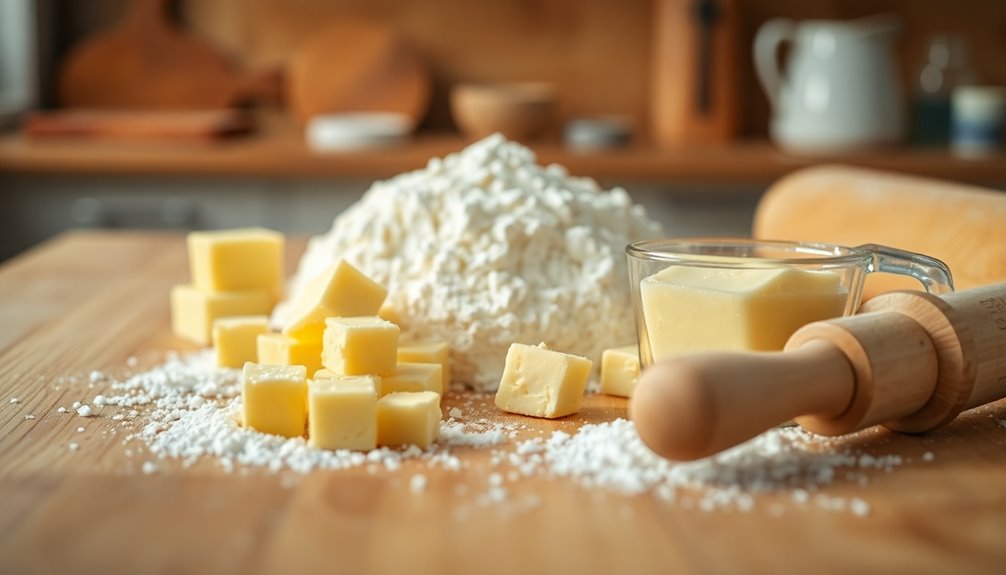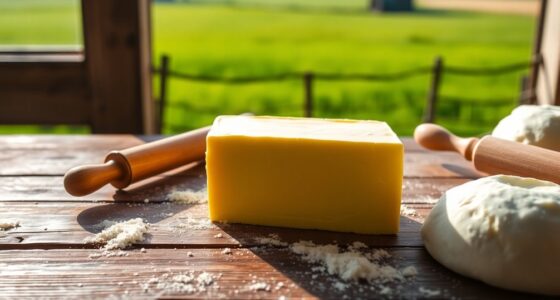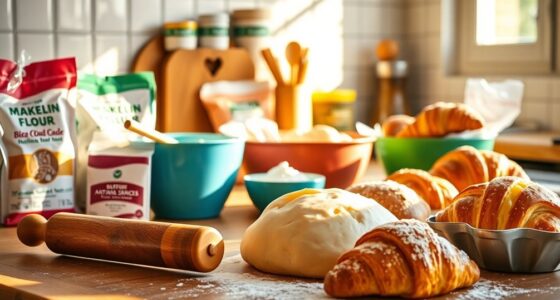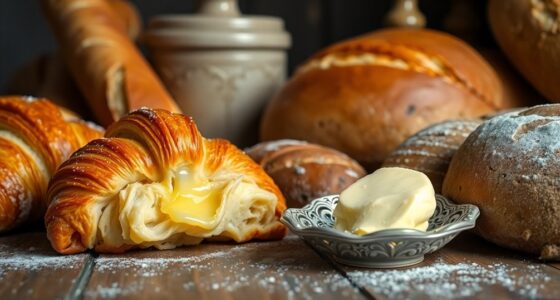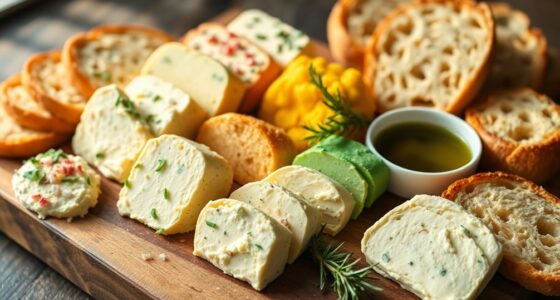Understanding butter ratios is essential to mastering dough for bread and pastries. You'll want to take into account factors like fat content and temperature. A higher fat content creates tender, flaky pastries while cold butter is best for lamination. Proper measurements guarantee the right texture; too little butter can make baked goods dry, while too much can lead to spreading. Knowing how to balance these elements will elevate your baking skills, revealing even more valuable insights as you continue exploring.
Key Takeaways
- Master precise butter measurements using a kitchen scale for consistent texture and flavor in dough.
- Understand specific butter ratios: 1:1:1:1 for moist cakes and 3:2:1 for cookies.
- Use high-fat content butter (82-85%) to enhance tenderness and flavor in pastries.
- Keep butter at 55°F (13°C) for optimal flakiness and to maintain solid state during lamination.
- Experiment with various butter types and ratios to discover your preferred flavor and texture combinations.
Understanding the Role of Butter in Dough
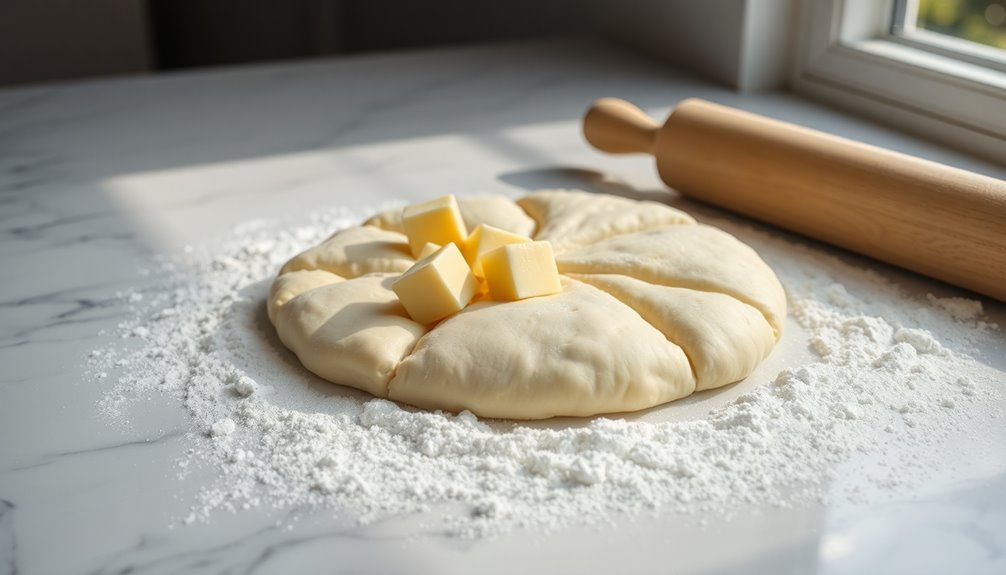
Butter plays an essential role in dough, especially when it comes to achieving that coveted flakiness in pastries. When you create laminated dough, the butter forms thin layers that enhance texture and mouthfeel.
To get the best results, keep your butter at around 55°F (13°C) during incorporation, as this helps maintain its integrity while you roll and fold. Using high-fat content butter (82-85%) instead of regular (80% fat) will improve tenderness and flavor.
Pay attention to the fat-to-flour ratio; a 1:1 ratio by weight is ideal for a flexible and manageable dough. Be cautious, though—overworking the dough can ruin the delicate layers you're aiming for, affecting both taste and structure. Additionally, using unsalted butter allows for better control over the overall saltiness of your baked goods.
The Importance of Ratios in Baking
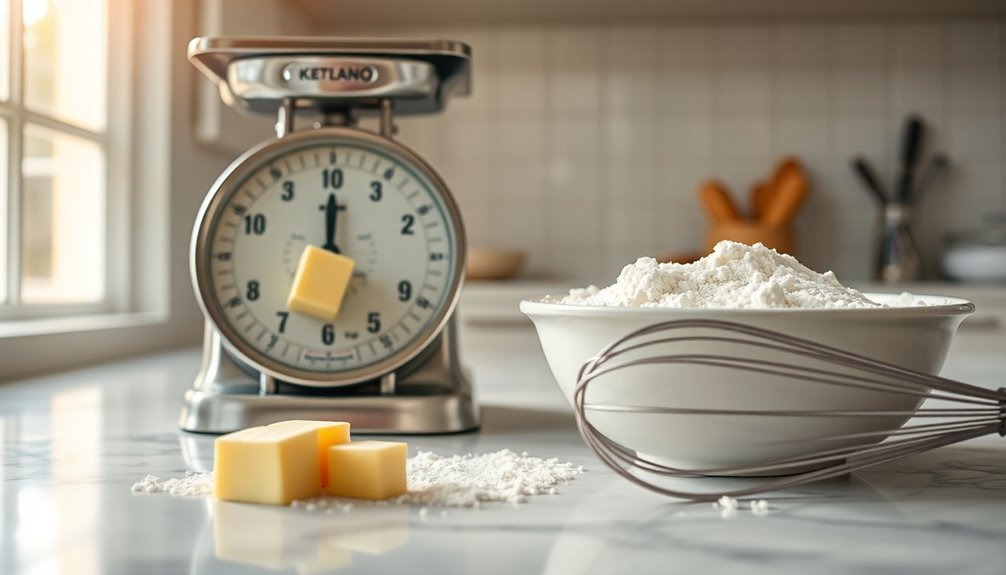
Understanding how to use butter effectively sets the stage for grasping the importance of ratios in baking. Ratios are essential for achieving the right texture and flavor. For instance, the flour to water ratio of 5:3 is vital for bread, while a 1:1:1:1 ratio of fat, sugar, eggs, and flour yields moist cakes. Cookies, on the other hand, often use a 3:2:1 ratio of flour to fat to sugar, which influences spread and texture.
| Recipe Type | Common Ratio |
|---|---|
| Bread | 5:3 (Flour:Water) |
| Cake | 1:1:1:1 |
| Cookies | 3:2:1 |
| Laminated Doughs | Varies |
| Pastries | Adjusted for fat |
Understanding these ratios lets you adapt recipes without compromising results. Mastering budgeting principles can also help you manage the costs associated with baking ingredients effectively.
How Butter Affects Dough Texture
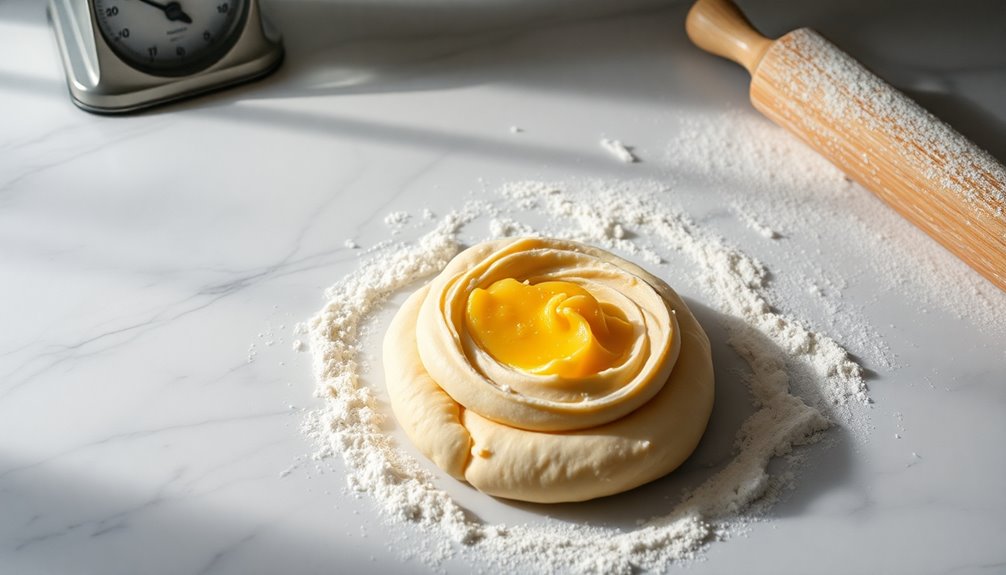
When you incorporate the right amount of fat into your dough, it can dramatically impact the texture of your final product. The fat-to-flour ratio is essential; a higher fat content results in tender, flaky pastries.
Using cold butter at around 55°F/13°C is vital for maintaining its solid state during the lamination process, creating distinct layers that promote a flaky texture. A 1:1 flour to butter ratio by weight enhances dough flexibility, helping the pastry hold its shape while contributing a rich mouthfeel.
Additionally, butter acts as a waterproof barrier, preventing your crust from becoming soggy by reducing moisture absorption during baking. The quality of your butter, especially European-style with higher fat content, can elevate both flavor and texture. Furthermore, the creamy texture of butter is influenced by the emulsification process during churning, which further enhances the overall mouthfeel of your pastries.
Best Practices for Measuring Butter
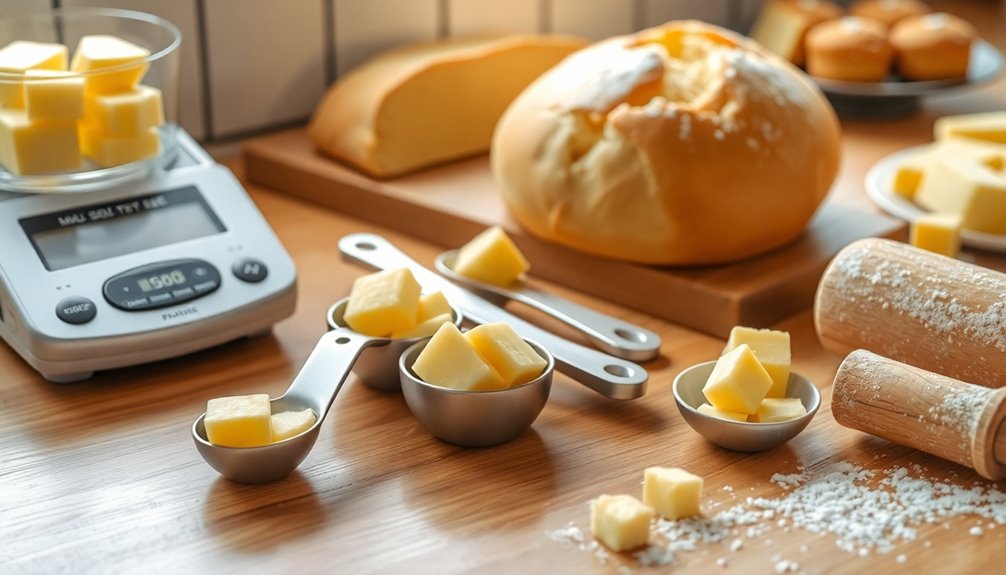
Incorporating the right amount of butter into your dough is just the beginning; measuring it accurately is equally important for achieving the desired results.
Use a kitchen scale for precision, as one stick of butter weighs 113 grams (4 ounces) or equals 1/2 cup. If your recipe calls for softened butter, let it sit at room temperature for about 30 minutes until creamy, but don't let it melt.
To measure by volume, fill a liquid measuring cup with water, add butter until the water level rises, then discard the water—this guarantees accuracy without squishing.
Tips for Incorporating Butter Into Dough
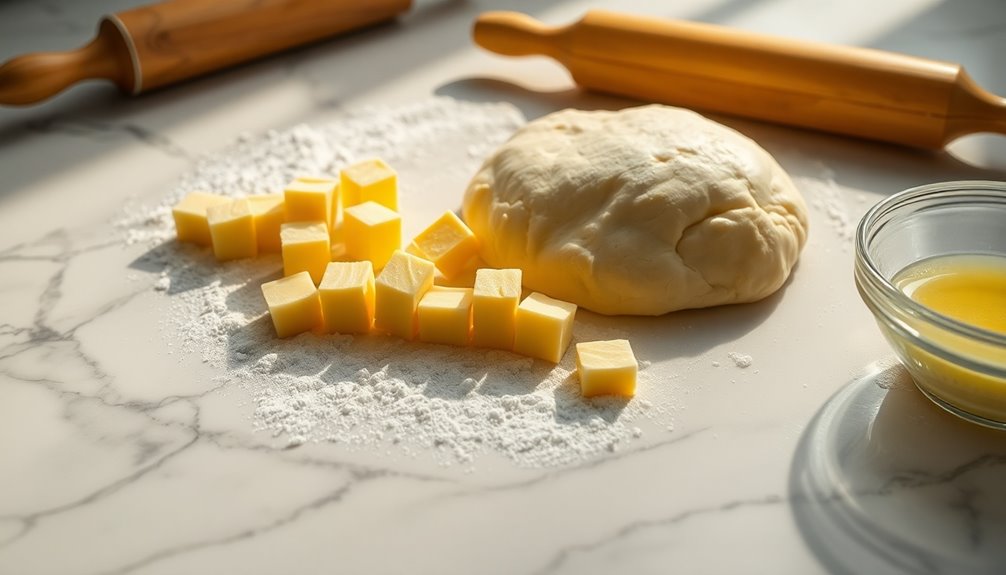
When you're incorporating butter into dough, the temperature is essential—keep it cold for the best results. It's also important to measure the butter accurately to maintain the right ratios for texture and flavor. Using butter making devices can greatly simplify the process, ensuring a consistent incorporation of butter into your dough. Let's explore how these factors can elevate your baking game.
Ideal Butter Temperature
To achieve the best results in your dough, aim for a perfect butter temperature of around 55°F (13°C). This temperature keeps the butter solid, ensuring distinct layers during the lamination process. Using cold butter helps maintain these layers, preserving a flaky texture. Warm butter can compromise your dough's structure, leading to loss of flakiness.
For ideal results, the butter should be pliable but not too soft, allowing for easy rolling and folding without breaking the dough. Consistent temperature is essential; incorporating butter that's too warm can result in uneven layers and a less desirable final product. Additionally, utilizing higher fat content in your butter can further enhance the richness and flavor of your baked goods.
| Butter State | Temperature (°F) | Result |
|---|---|---|
| Cold Butter | 32-40 | Good for flaky textures |
| Ideal Butter | 50-55 | Best for lamination |
| Soft Butter | 60-70 | Poor for flaky layers |
| Warm Butter | 70+ | Compromised dough structure |
Butter Measurement Techniques
Achieving the right butter measurement is essential for creating a successful dough. Use butter measurement techniques that emphasize a 1:1 weight ratio of flour to butter for ideal flexibility.
Start with cold butter, around 55°F (13°C), to guarantee flakiness in your pastry dough. Cut the butter into cubes no smaller than 1/2 inch and gently smash each cube flat with your fingertips. This method prevents overworking the dough while promoting even distribution.
Gradually incorporate the butter into the flour mixture, using a pastry cutter or your hands. Keep the butter chunks intact to maintain texture. As you mix, add flour as needed until your dough is formed.
Historically, butter has been a symbol of wealth in many societies, reflecting its importance in culinary traditions.
Finally, remember to fold the dough gently during the baking process for best results.
The Impact of Butter on Flavor and Aroma
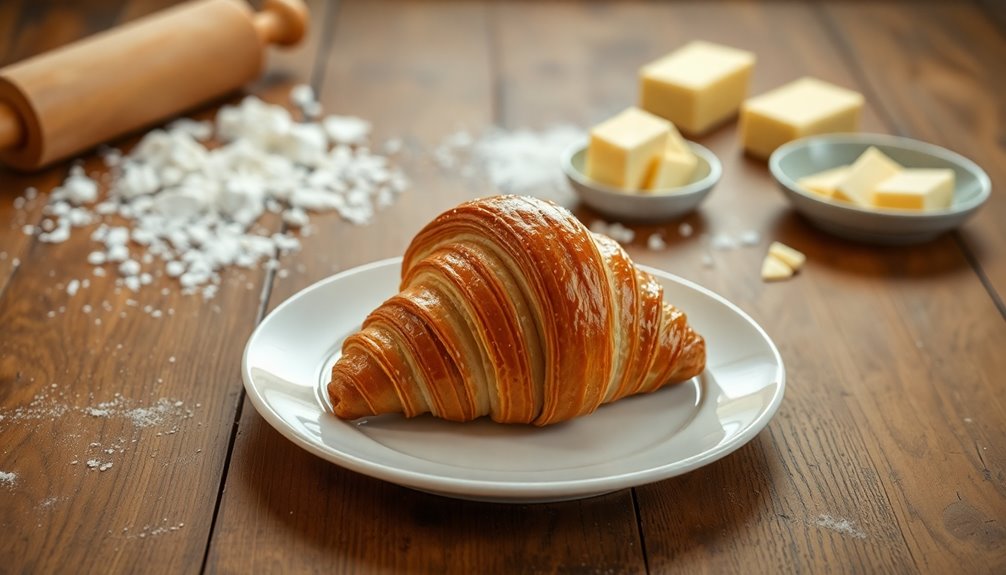
Butter plays a pivotal role in shaping the flavor and aroma of baked goods, elevating them from simple recipes to culinary delights. Its high-fat content, typically 80% to 85%, contributes a rich, creamy flavor that enhances your pastries and bread. The type of butter you choose matters too; European-style butter brings a more nuanced aroma than standard options.
When you incorporate butter into your dough, the steam generated during baking releases aromatic compounds that enrich the final product. Plus, using unsalted butter gives you better control over salt levels, ensuring a balanced flavor profile.
| Type of Butter | Flavor Profile | Aroma Characteristics |
|---|---|---|
| Unsalted Butter | Creamy, Rich | Subtle, clean |
| European-Style Butter | Pronounced, Nuanced | Intensely aromatic |
| Standard Butter | Mild, Basic | Light, less complex |
Common Mistakes to Avoid When Using Butter
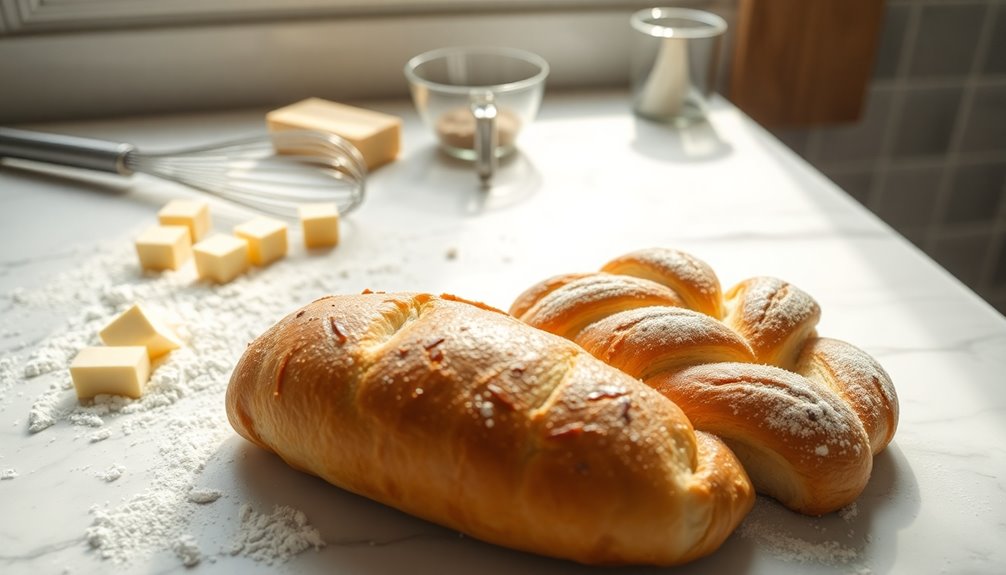
Many bakers unknowingly make mistakes when using butter that can ruin their dough's texture and flavor. One common error is using warm butter instead of cold, which can lead to a loss of flakiness in laminated pastries.
Overworking the dough when incorporating butter develops excess gluten, resulting in tough pastries rather than the tender texture you want. Inadequate chilling time between folds allows the butter to melt into the dough, preventing those essential distinct layers.
Additionally, failing to use high-quality butter can compromise both flavor and texture. Ultimately, skipping resting periods between rolling and folding can hinder gluten development, affecting the overall elasticity and structure of your dough.
Avoid these pitfalls for perfect pastries every time!
Frequently Asked Questions
How Much Butter Do You Put in Bread Dough?
When you're making bread dough, you typically want to use about 1 to 2 tablespoons of butter per cup of flour.
This amount can vary depending on how rich you want your bread to be. Remember, softened butter works best for even mixing.
If you're aiming for a more decadent loaf, like brioche, you might increase that to as much as 50% of the flour weight for a truly indulgent treat.
What Is the Ratio for Bread Dough?
You might think that making bread dough is complicated, but it's really about finding the right balance.
The basic ratio is 5 parts flour to 3 parts water, which helps with hydration and gluten formation. If you want to add flavor, toss in sugar and salt—salt should be about 2% of the flour weight.
Don't forget yeast for that rise!
Experimenting with flour types can also elevate your bread game.
What Are the Ratios for Pastry?
When making pastry, you typically follow a 3:2:1 ratio of flour, fat (like butter), and water. This means for every three parts flour, you use two parts fat and one part water.
For flaky pastries, guarantee your butter's cold and cubed, and don't fully mix it in. Folding the dough several times creates those lovely layers that give your pastries a light, flakey texture.
Chilling between folds is key for success!
What Happens if You Put Too Much Butter in Bread Dough?
If you put too much butter in your bread dough, you'll end up with a greasy texture that hinders proper rising.
The excess fat can interfere with gluten development, leading to dense bread.
You'll notice the crust browning too quickly while the interior remains undercooked.
Plus, your bread might've a soft crumb that doesn't hold its shape well after slicing, and it could negatively affect the overall flavor and aroma.
Conclusion
Mastering butter ratios can transform your baking game, whether you're crafting flaky pastries or crusty bread. Remember, using the right butter amount not only enhances texture but also elevates flavor. For instance, a baker named Sarah adjusted her butter ratio for croissants, resulting in a lighter, airier pastry that wowed her customers. By applying these tips and avoiding common mistakes, you'll create delicious dough that keeps everyone coming back for more. Happy baking!
